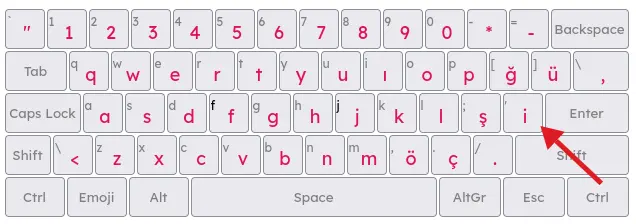If you have ever used a Turkish-Q keyboard in combination with a modal editor
before, you might have noticed that the i key is pretty far off to the side:

This blog post will guide you on how to swap the ı key with the i key (but
not the I and İ keys). This will be a great change if you write primarily in
English but need the Turkish symbols sometimes.
There is
tr(us)in thexkeyboard_configpackage that does something similar to this:// The basic Turkish layout with "i" and "ı" swapped. // Originally by Ali Riza KESKIN <parduscix@yandex.ru>, 2021. partial xkb_symbols "us" { include "tr(basic)" name[Group1]="Turkish (i and ı swapped)"; key <AC11> { type[group1] = "FOUR_LEVEL_SEMIALPHABETIC", [ i, I, paragraph, none ]}; key <AD08> { type[group1] = "FOUR_LEVEL_SEMIALPHABETIC", [ idotless, Iabovedot, apostrophe, dead_caron ]}; };However, this only swaps the uppercase letters, so the
ikey is unchanged but the uppercase of that key isIlike in English. However, this is usually not desired as this still reduces your typing speed (as theiIkey is too far).
Let's create our own layout that does something similar but swaps the lowercase letters instead. Here is the code for that:
default partial
xkb_symbols "basic" {
include "tr(basic)"
name[Group1]="Turkish (i and ı swapped correctly)";
key <AC11> { type[group1] = "FOUR_LEVEL_SEMIALPHABETIC",
[ idotless, Iabovedot, paragraph , none ]};
key <AD08> { type[group1] = "FOUR_LEVEL_SEMIALPHABETIC",
[ i , I , apostrophe, dead_caron ]};
};
The default key is needed because we are going to make this a standalone file.
Save this to ~/.config/xkb/symbols/tr-swapped-i and you can tell your WM/DE to
use the tr-swapped-i XKB layout.
In Hyprland (The WM I use) you can do it like this:
# In ~/.config/hypr/hyprland.conf
input {
kb_layout = "tr-swapped-i"
}
That should swap the ı and i keys on your WM/DE successfully. However, we
are not done yet.
The TTY (swap to TTY 2 by doing CTRL-ALT-F2) still doesn't use this layout,
which is a problem. And it seems that the format the TTY uses is a little
different. Looking at the kbd package, it uses a format called .map.
Here is a .map file that overrides the trq layout and swaps the ı and i
keys:
include "/usr/share/keymaps/i386/qwerty/trq.map"
keycode 23 = i
altgr keycode 23 = +icircumflex
altgr shift keycode 23 = +Icircumflex
keycode 40 = +dotlessi +Idotabove
Save it to the directory where you store your maps.
Note that the path /usr/share/keymaps might differ based on your distro. You
can check what it is it by doing man loadkeys and scrolling to the bottom.
After that, consult your distro's docs on how to change the system keyboard locale.
This is how it is done on NixOS:
{ pkgs, ... }: {
console.keyMap = pkgs.writeText "trq-swapped-i.map" ''
include "${pkgs.kbd}/share/keymaps/i386/qwerty/trq.map"
keycode 23 = i
altgr keycode 23 = +icircumflex
altgr shift keycode 23 = +Icircumflex
keycode 40 = +dotlessi +Idotabove
'';
}
And this is how it is done on Arch:
cat << :end
include "/usr/share/kbd/keymaps/i386/qwerty/trq.map"
keycode 23 = i
altgr keycode 23 = +icircumflex
altgr shift keycode 23 = +Icircumflex
keycode 40 = +dotlessi +Idotabove
:end > /usr/share/kbd/keymaps/i386/qwerty/trq-swapped-i.map
localectl set-keymap --no-convert tr-swapped-i
After that, your TTY should also use this locale.
Gotta love having to mess with deep parts of your system because the Turkish-Q
layout did the big mistake of reusing the i key as ı!
At least I'll type and edit faster now...
Here is the commit where I implemented this, might be worth a look if you use NixOS.